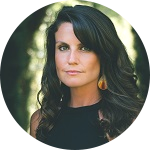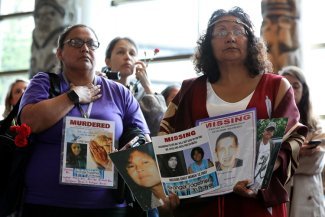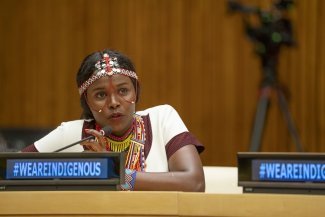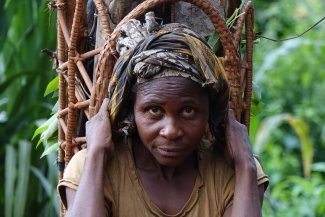
A ceremony was held on 21 October 2022 to launch a birch bark canoe, built by Wahkohtowin Development with materials harvested solely from the land, on the Chapleau River in Ontario, Canada. Cultural revitalisation is considered a critical component of reconciliation.
Near the shores of Grassy Lake in Ontario, Canada, Amberly Quakegesic follows Adrienne Beaupre down a narrow path into the forest. It’s autumn – the sun strong, the air crisp – and Quakegesic pays careful attention as Beaupre, a medicine woman from Chapleau Cree First Nation, describes the medicinal uses of the plants they encounter.
“If you scrape the dust off the poplar tree and rub it on your skin, it can be used as sunscreen,” says Beaupre. Pausing at a yarrow plant, standing tall above the foliage, she continues: “If you have a cut, the leaves of this act as a blood coagulant. Stick the leaves on and cover the cut.” Further down the trail she points to rat root, known for its pain-relieving effect. “If you have a toothache, use that.”
Although Quakegesic grew up outside of her Nation’s culture, she always felt connected to nature. But when she started working with Wahkohtowin Development, a social enterprise of the Chapleau Cree, Missanabie Cree and Brunswick House First Nations in northern Ontario, whose traditional territories are blanketed by forests and freshwater, her relationship with nature transformed.
Learning from Elders, exposure to her Nation’s culture and teachings about the land were a homecoming. “Our ancestors were engineers and doctors, but Indigenous peoples were discredited as savages and unintelligent. Obviously, they were [intelligent] if they survived in some of the harshest places and were prosperous, cultural and healthy,” says Quakegesic.
“If you’re not taught to be proud of who you are and where you come from, the rest of society will teach you otherwise.”
Across Canada, a thriving movement of Indigenous peoples reconnecting with their land and culture and stewarding their Nation’s traditional territories are heralding a new era for conservation. Centering Indigenous peoples in conservation efforts is widely considered the only way Canada can meet its 2030 biodiversity targets. But the merits of Indigenous-led conservation go far beyond preserving biodiversity. By supporting cultural and linguistic revitalisation, land-based healing, and the reshaping of relations between Indigenous and non-Indigenous societies, Indigenous-led conservation represents an opportunity for true reconciliation.
Towards reconciliation
In recent decades, the Canadian government began a process of reconciliation to establish and maintain respectful relationships between Indigenous and non-Indigenous societies, following its history of colonisation, attempted assimilation and genocide towards Indigenous peoples.
Valérie Courtois, a member of the Ilnu community and executive director of the Indigenous Leadership Initiative, an organisation strengthening Indigenous leadership and advancing Indigenous-led conservation nationwide, says a dream persists of Canada as a country of justice, equity, fairness and leadership. “The only way Canada can achieve that is by reckoning with its past and rebuilding a collective future where we all prosper and we’re all recognised for our roles.”
In 2018, a historical report was released exploring how Indigenous-led conservation could help Canada meet its conservation goals in the spirit and practice of reconciliation. “It was a transformational moment,” says Alison Woodley, senior strategic advisor for the Canadian Parks and Wilderness Society.
“It elevated the importance of recognising Indigenous models of protection and protected areas, that that was key to the path forward and could deliver on targets and that it could help contribute to Canada’s efforts to reconcile Indigenous and non-Indigenous peoples.”
Since then, Indigenous-led conservation has gained rapid momentum and received over C$1 billion in federal funding. For Indigenous peoples, it’s an ironic turn of events. When national parks like world-renowned Banff and Jasper were established, Indigenous Nations were forced from traditional territories they had stewarded for millennia. Known as ‘fortress conservation’, this exclusionary model that came to dominate global conservation policy is based on the belief that biodiversity is best protected when ecosystems can function without human disturbance. In practice, the model is built on racism, colonialism, dispossession and violence.
Indigenous-led conservation, in contrast, is rooted in respect and reciprocity for the environment and the philosophy that if people care for the land, the land will care for them.
A flourishing model
After decades of perseverance, Indigenous efforts have made notable progress in recent years setting aside vast tracks of land, freshwater and oceans on an unprecedented scale. Nationwide, Indigenous Nations have proposed Indigenous Protected and Conserved Areas (IPCAs), based on Indigenous laws, governance and knowledge systems, that could collectively conserve over 500,000 square kilometres.
In northern Manitoba, for example, three Indigenous Nations aim to protect the entirety of the Seal River Watershed – 50,000 sq km of forests, tundra, rivers and wetlands – from industrial activity. In Nunavut, a large, sparsely populated territory in northern Canada, the Qikiqtani Inuit Association and the federal government are working to establish the 109,000 sq km Tallurutiup Imanga National Marine Conservation Area, home to narwhals, polar bears, walruses, beluga whales and some of the Arctic’s most important seabird breeding colonies.
IPCAs support decolonisation, by promoting Indigenous governance models, conservation and sovereignty, and the survival of ancestral wisdom.
“IPCAs hold up language and culture as the most important aspect, because in those languages and cultures we have thousands of years of knowledge about biodiversity. If you lose the language, you lose that knowledge,” says Eli Enns, member of the Tla-o-qui-aht First Nation and president, CEO and co-founder of the IISAAK OLAM Foundation, an Indigenous education non-profit working nationwide.
Indigenous Guardians programmes, which also facilitate the transmission of knowledge, language and culture, are similarly furthering reconciliation. Guardians, the ‘eyes and ears’ on traditional territories, are trained experts responsible for helping Indigenous Nations steward their lands and waters. Guardians with Wahkohtowin Development tap birch trees to collect sap, build canoes with materials harvested solely from the land and run vegetation surveys to reduce herbicide use. Elsewhere in Canada, Guardians monitor resource development, measure water quality and help create land- and marine-use plans. There are now over 120 Guardians programmes in every province and territory.
“Guardians programs connect you with the land, but they also connect you with your community and culture,” says Quakegesic, Wahkohtowin Development’s Guardian program manager. “We learn about species and medicines, and what healthy trees need to survive. We truly get to connect with nature and understand how much it has to offer.”
“It’s a really meaningful job for individuals because we’ve gone through genocide, the horrors of residential schools and an attempt of assimilation,” says Courtois. “Part of our light at the end of the tunnel is a reappropriation of that culture and a reassertion of who we are. That means healing and addressing some of the social ills that resulted from that experience. And part of the solution is reconnecting with the land.”
Centring Indigenous stewards
Canada, which hosted the 2022 UN Biodiversity Conference, has committed to the global goal of protecting 30 per cent of its oceans, lands and freshwater by 2030. Currently, 13.5 per cent of the country’s land and 13.9 per cent of its oceans are protected. Indigenous and non-Indigenous experts agree Canada’s ambitious targets cannot be met without centring Indigenous-led conservation initiatives.
The effectiveness of Indigenous-led approaches is gaining belated recognition among non-Indigenous societies. Globally, Indigenous lands make up around 20 per cent of Earth’s territory while supporting 80 per cent of the world’s remaining biodiversity. Meanwhile, research is challenging the myth sustaining fortress conservation. A study from Canada, Brazil and Australia, for example, found that Indigenous-managed lands were slightly richer in biodiversity than protected areas, and that Indigenous-managed lands supported more threatened species than protected or non-protected areas in Canada and Brazil.
The benefits of Indigenous-led conservation go far beyond preserving biodiversity. Analyses of several Guardians programmes found they lead to numerous social, cultural, economic and environmental benefits for Guardians and their communities, including improved health and well-being, more role models for youth and reduced crime rates.
“Because of the colonial experience, we have all the indicators that you’d expect. We’re overrepresented in jails and in the justice system. We’re overrepresented in the social services and child welfare systems. We’re underrepresented in higher education institutes. And Guardians [programmes are] hitting all of those and having a positive impact,” says Courtois. “I’m determined it’s important for the Earth and it’s absolutely a conservation action. But first and foremost, it’s an expression of social justice.”
Still a long way to go
According to Courtois and Enns, further advancement of Indigenous-led conservation is hindered by systemic racism, prejudice, fear, insecurity and a scarcity mindset. “It’s in our inner worlds of values and beliefs,” says Enns.
Siloed thinking which views everything as disconnected is also an obstacle, Enns adds, highlighting the Nuu-chah-nulth philosophy of hishuk’ish tsawalk: everything is one and everything is interconnected. “Conservation through reconciliation is saying to the conservation sector in Canada that if you want to save caribou, polar bears, salmon, the best way, and to me the only way, to do that is through reconciling amongst ourselves and reconciling worldviews and knowledge systems,” he says.
Holly Jonas, global coordinator of the ICCA Consortium, an international association supporting Indigenous and community conserved areas, says the Canadian government’s support for Indigenous-led conservation, although arguably world-leading, remains insufficient and that pressing concerns remain about their much larger investments in fossil fuel extraction, pipelines and mining in Indigenous territories.
“It’s understandable that some Indigenous Nations and leaders are not falling over themselves to thank the government for nominally investing in IPCAs when their customary laws, institutions and cultures are otherwise being systematically undermined, and they are being criminalised for defending their territories and themselves against federally subsidised industries – the same industries that are the direct drivers of biodiversity loss and climate breakdown,” says Jonas.
Despite these challenges, recognition is growing that Indigenous-led conservation is the future of conservation in Canada. “I’m convinced that it’s transforming the conversation in this country about our relationship with these places, our responsibilities and how we might do better as a society,” says Courtois.
Quakegesic’s journey to reconciliation has required her to face stereotypes, biases and fears, and confront how the horrific past continues to reverberate in the present. “A lot of what I do is unlearning,” she says. “[There’s] a lot of unlearning for all of us to do.” But through her work connecting with her community, culture and the land, there has been healing, too: “A lot of the successes we have are immeasurable.”












